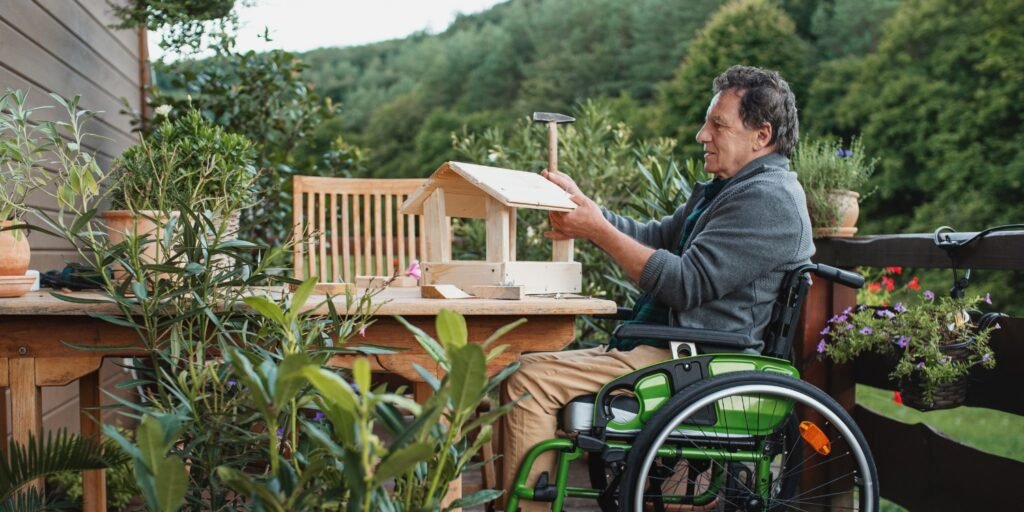Tufting for Seniors: Low-Strain Tools and Tips

Last Updated on August 12, 2025 by Rose Ann
The best part of your golden years is the time you can shape. A quiet corner. Warm light. Colors that feel like home. Tufting gives your hands a gentle rhythm and your mind a calm place to rest. Each small finish becomes a keepsake you can see and touch every day.
It fits the way you live now. Short sessions. Simple shapes. Projects that start small and still feel meaningful. You choose the pace, sit or stand as needed, and enjoy screen-free hours that ease stress. Finished tufted rugs make lovely gifts, spark stories, and bring a fresh sense of purpose to the week. With tools like a rug tufting gun, you can easily create a meaningful project you can share.
Crafting a Two-Color Mat
Start with a small 40×60 cm piece. The workflow is easy on hands and joints and keeps setup, trimming, and cleanup quick.
Tools and materials
- Lightweight rug tufting gun with slow speed control (a compact model like ClawLab works well)
- Foldable frame and primary backing cloth
- Tightly spun yarns in two colors
- Projector or fine fabric marker and ruler
- Low-odor rug adhesive and secondary backing or felt
- Cotton binding tape or edge fabric
- Curved shears, detail trimmer, stiff brush
- Clamp light, foam floor tiles, anti-fatigue mat, safety glasses, small vacuum
Steps
- Plan a bold shape with two colors. Keep lines simple and high contrast.
- Prepare the space. Lay foam tiles, set the clamp light, and adjust your chair or mat for comfort.
- Mount and tension the backing. Align centerlines and stretch to a firm, drum-tight feel.
- Test on scrap. Set a low speed and confirm stitch depth and yarn feed look even.
- Transfer the design to the backing with a projector or thin marker lines.
- Outline slowly with short, steady passes. Keep a neutral wrist and check the front often.
- Fill large areas in straight lanes. Pause every ten minutes to relax your hands and shoulders.
- Glue the back in a thin, even coat. Press the secondary backing, let it cure fully, then brush, trim high spots, and bind the edges.

Why Tufting Appeals to Seniors
Creative control draws many seniors in. You choose colors, shapes, and textures that fit your home and your story. Simple designs still look rich and personal. The work is tactile and soothing. You see progress fast, which keeps motivation high. Finished pieces also make heartfelt gifts for family and friends.
Comfort matters, and tufting adapts well. You can sit or stand and keep sessions short. Neutral wrist positions and light tools reduce strain. A small frame fits into quiet corners. Slow, steady passes keep noise down in shared spaces. Gentle pacing turns craft time into pleasant routine.
Community and purpose follow. You can tuft with a partner, teach a grandchild, or join a local group. Sharing swatches and techniques builds confidence. Small projects sell easily at fairs or online. The process encourages focus and mindfulness. Each rug becomes a daily reminder that creativity doesn’t retire.
Ergonomics First
Ergonomics makes tufting comfortable and sustainable, even in tight home setups. Small changes in posture, tool choice, and pacing protect hands and shoulders so you can enjoy sessions now and keep crafting for years.

- Neutral Wrist and Grip
- Keep your wrist straight and your elbow close to your side. Hold the rug tufting gun like a marker, not a hammer. Aim for a light grip, about three out of ten. Let the forearm glide, not the shoulder. Avoid bending the wrist toward the pinky or thumb. Rest your non-dominant hand on the frame for balance.
- A lightweight model, such as ClawLab, helps you relax the hand and keep stitch depth consistent. Do a quick warm-up with wrist circles before each session. If you feel pressure spots, add a soft wrap or finger tape.
- Standing vs Sitting
- Switch positions on purpose. Stand for tracing outlines where reach and sightlines matter. Sit for infill to drop the shoulders and steady your pace. Use a height-adjustable stool so that your hips stay level with your knees.
- Keep both feet flat and avoid perching. Stand on an anti-fatigue mat when upright. Set a timer to change positions every 10 to 15 minutes. Small posture resets prevent tight necks and sore lower backs.
- Frame Height and Reach
- Set the frame so its center sits near mid-torso. Your elbow should bend close to ninety degrees. You shouldn’t reach past your forearm to hit the far edge. If you’re stretching or shrugging, raise the frame or move it closer. Adjust a foldable stand or wall cleat instead of changing your posture. Rotate the frame to bring the active area to you. Shorter reach keeps lines clean and cuts fatigue.
- Speed Control and Micro-Breaks
- Use slow speed for outlines, corners, and tight turns. Step up one notch for open fields. Keep passes steady rather than fast. A variable dial, like on ClawLab, makes these changes easy. Pause every ten minutes for a quick shakeout. Open and close the fingers, then roll the shoulders. Look across the room to rest your eyes and reset focus. Frequent tiny breaks beat one long rest and keep stitches even.
Senior-Friendly Setup for Rug Tufting
Seniors and early retirees can enjoy tufting at home with a setup that’s gentle, quiet, and easy to maintain. Plan for comfort, safety, and pets so craft time stays stress-free.
- One-Square-Meter Floor Plan
- Claim a single corner and map a one-square-meter zone. Anchor the frame on a clear wall. Park a small rolling cart on your dominant side. Keep the vacuum and a trash bin under the frame. Tape a floor outline so every tool returns to the same spot. Muscle memory reduces bending, searching, and unnecessary steps. You’ll set up faster and end with less fatigue.
- Noise Damping That Respects Neighbors
- Soft surfaces absorb sound and vibration. Place dense foam tiles under the frame and felt pads anywhere wood touches wall or floor. Close door gaps with a sweep. Work at lower speeds during daytime hours to keep peace in shared buildings. A quick message to a next-door neighbor before longer sessions builds goodwill. Quiet habits make the craft sustainable.
- Ventilation and Low-Odor Materials
- Open a window or run a small fan during adhesive work. Choose low-odor products and cap containers immediately. Keep lint down with short, frequent vacuum passes. A compact HEPA purifier helps if you’re sensitive to dust. Good airflow makes sessions easier on lungs and sinuses. Clean air supports longer creative streaks without discomfort.
- Power, Cables, and Switches
- Use a surge protector with a big, easy-to-see master switch. Route cords along the wall with adhesive clips to prevent snags. Add a foot switch if it helps you keep both hands steady on the work. Unplug the rug tufting gun and vacuum after each session. Coiled cables reduce trip risks. Simple power habits raise safety without slowing you down.

- Lighting and Contrast for Aging Eyes
- Bright, neutral light reduces squinting and head tilt. Aim a clamp light directly at the stitch path. Add a second lamp behind your shoulder to kill shadows. Use bulbs with high color rendering so yarn hues stay true. Keep the wall behind the frame light in tone for better contrast. Clear sightlines help you spot gaps before glue sets.
- Stable Seating and Floor Support
- If you sit, use a height-adjustable stool with a supportive back. Keep both feet flat and avoid perching on the edge. If you stand, place an anti-fatigue mat under your stance. Wear supportive shoes instead of slippers. Stable footing steadies your hands and protects your knees and hips. Comfort extends productive time without soreness.
- Pet-Smart Boundaries
- Pets are family, yet they add motion and fur. Close the door during glue work and trimming. Store yarn in sealed bins, not open baskets. Hang a simple sign that reads ‘Studio Open’ or ‘Studio Closed’. Place a cozy pet bed outside the door so companions can stay nearby without wandering in. Clear rules keep projects clean and animals safe.
- Storage That Protects Joints
- Think vertical and rollable. Hang the frame on wall hooks to save floorspace. Store the gun in a hard case with desiccant to protect parts. Keep heavier items on the middle shelves of your cart to avoid deep bends. Label drawers with large, high-contrast text. Smooth, waist-height access reduces strain on backs and shoulders.
- Cleanup Routine You’ll Keep
- End each session with a quick sequence. Vacuum the frame, then the floor, then your clothing. Bag lint and offcuts right away. Wipe tools, check loose screws, and log any issues to fix next time. Five minutes of tidy work prevents clutter and dust from spreading through the home. Consistent habits make tomorrow’s setup instant.
- Quiet Gear and Vibration Control
- Choose lighter tools with steady speed control to cut buzz and hand fatigue. A compact, well-balanced option keeps outlines precise at slower speeds and stores away easily. Place foam under the frame to tame vibration that travels through floors and walls. Keep passes smooth rather than fast. Less shake means cleaner lines and happier joints.
- Safety Checks and Emergency Prep
- Scan your posture before you start. Feet flat. Wrists neutral. Shoulders relaxed. Keep a small first-aid kit on the cart and know where your building’s extinguisher sits. Store adhesives away from heaters and direct sunlight. If you use hearing aids, confirm they’re comfortable with your noise level. A short checklist turns safety into a simple routine you’ll follow every time.
Conclusion
Tufting at home can be doable, creative, and rewarding at any age. With smart ergonomics, quiet setups, and simple designs, you protect joints and keep projects fun. A well-chosen rug tufting gun and light tools turn practice into confidence. Start small, pace sessions, and use tidy workflows that respect apartment living. You’ll finish pieces you’re proud to display, gift, or sell.
Rug tufting is one way of finding meaning during your golden years. Read our guide on how to find purpose in your retirement next!





